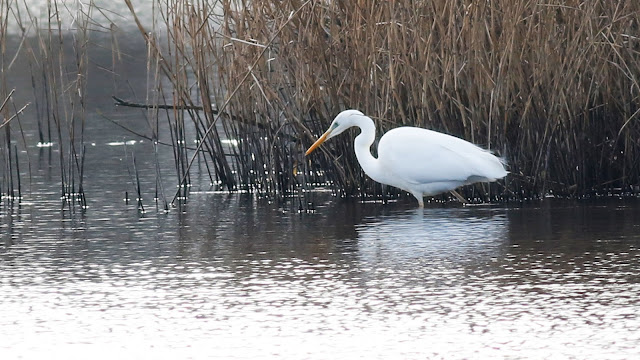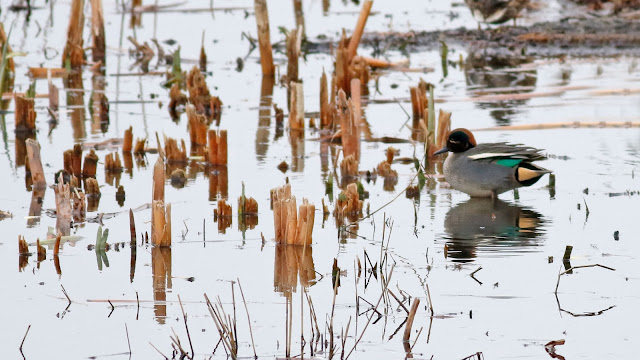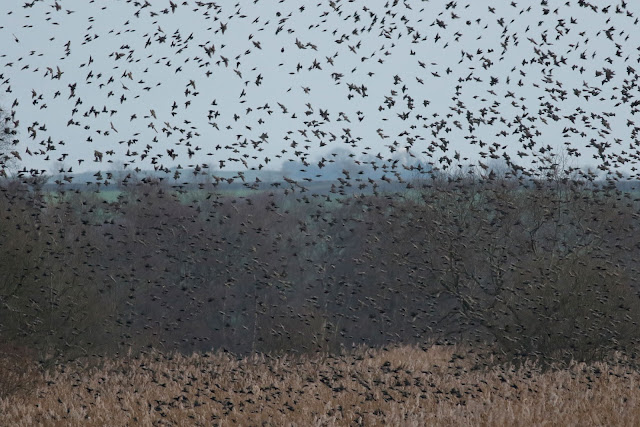A very distant Whooper Swan was pointed out to us by one of the wardens in the car park. I hoped that maybe it would be a little closer when we returned, getting all three swans in the UK so early in the year is something I have not managed before.
We headed down the main path, stopping at the island hide to listen for Bearded Tits of which there was no sign. The moor is heavily comprised of peat, and in many places the extraction of peat has formed lots of dark pools, lakes and ponds. As we walked along the path passing one of the pools a Mute Swan sat in the black water.
At the far end of the reserve there is a complex of reed bed and open water, in the middle of the open water I picked up a pair of Goosander, the drake standing out.
We found our way to a large hide with two storeys, it was one of the most substantial hides I think I have ever been i, with solid pine pillars, fire doors and heavy windows. Unfortunately there was not much to see though, a pair of Gadwall, a Water Rail that flew past very quickly, and a pair of Tufted Duck, the male of which was hard to resist.
Beyond the reed bed there was open water and we could hear the calls continually of warring Coot. A pair of Mute Swans took off and flew low over the reeds and then past the hide
The drake Gadwall came close to the hide and showed once again the beautiful waved patterns in grey on the breast and flanks
We walked around to the viewing screen on the west side of the path, Here thee was more open water and as a result a lot more activity and birds on the water. A Great Egret was tucked behind the bushes north of the pools, but another flew across the lake to the south and settled in front of a small bank of reeds.
It then proceeded to stalk slowly along the edge of the reeds looking for possible prey using the reeds as shelter
As ever in winter sunshine the reeds were casting some lovely colour, and the water their own special reflections
On the far bank was a Little Egret and this Grey Heron, standing tall and proud above the reeds
In the middle of the lake a single, lone Great-crested Grebe
It was time to move on, and as we headed back down the main path the Goosander were closer. The group consisted of four pairs, and this drake came close as it flapped its wings.
We stopped off at another hide on the way back, there were no birds about, but the shallow dark water provided the perfect reflection for the partial blue and cloudy sky.
Back at the car park I looked once again for the Whooper Swan, finding it feeding on its own away from the Mute Swans. I took a few photos but reckoned I would be closer if I were to stop on the road when we left the car park. I was able to find a spot to pull over, and sure enough it was closer, and very confiding.
There are two species of swan that come to the UK each winter: Whooper Swans migrate from Iceland and the Bewick's Swans we saw yesterday at Slimbridge make the journey from Siberia.
The first challenge with wild swans is to distinguish them
for the more familiar Mute Swan. Both Whooper
and Bewick’s have rather wedge-shaped bills with a large yellow patch at the
base. This alone is enough to separate them from Mute Swan, which has an orange
bill with a large black ‘knob’ at the base, largest on breeding adults
(particularly males).
At a distance, Mute Swan has a thick neck that is often held
in an ‘S’ shape, and its rather rounded back profile is often exaggerated in a
threat posture in which the wings are arched high above the back. Here you can see the long straight neck.
The Whooper Swan, measures about five feet (roughly 150 cm) similar in size to the Mute Swan. However, Bewick’s is only about two-thirds the weight of the Whooper.
In the field, the Bewick’s appear much smaller, slighter,
shorter-necked, rounder-headed, more agile and rather more goose-like.
Whooper is a more majestic, long-necked bird with a longer, more wedge-shaped
head and bill profile and a more prominently bulging breast.
However it is the bill pattern that determines the
identification. Whooper has a long,
pointed wedge of yellow extending about three-quarters of the way to the bill
tip so that, at any distance, the majority of the bill looks yellow.
Bewick’s has a shorter bill with a more rounded or squarer
patch of yellow that covers just the base half of the bill.
Here you can see the subtle differences side by side, Whooper on the left, Bewick's on the right
We moved, our next stop to be the RSPB reserve at Ham Wall, as we pulled into the car park it was clear that this was a popular place and that arriving now was probably a good idea as parking places were becoming a premium. The main show was still two hours away, so we had some time to explore the reserve.
Walking down the main path we passed the first viewing platform with lovely views north across the reed bed.
We headed out through the reeds to the Avalon Hide. It looks out across the reeds, and away to the north east is dominant presence once again of Glastonbury Tor.
Closer in, the hide looks out over a reed bed
As is the case all around the Avalon Marshes, you are never too far away from a Mute Swan, nad if you are they will come to you
There was little activity in front of the hide, Shoveler and Teal roosting close to the reeds
There was a brief appearance of a male Marsh Harrier distantly over the reeds, but the overall atmosphere was one of calm, quiet solitude. A Heron sat in the reeds with its head hunched down on the shoulders. A view that always reminds me of Ladybird books from my youth - "What To See in Winter"
The main event was approaching fast so we headed back to the wall, Cetti's Warblers called from within the reeds as we walked through the reed bed. We set ourselves close to the Viewing platform, the light was beginning to fade, the sky taking on a tone of pink in amongst the very pale blue, the temperature was falling too, many peiople were gathering too, there was a general hum of conversation punctuated by the cries and screams of young children as they raced around the area.
Remarkably this had no effect on the birds, just beyond the platform a Great Egret hunted the edge of the water.
As the sun dropped, flocks of Lapwings appeared overhead, circling above us and then dropping down on to the open water, collecting with others already in place.
They would jostle and their calls would signal a panic and the birds fly up and circle once again, this time around the reeds, but back to the same place.
The Lapwings would continue to flow in, every time they appeared above heads would turn skywards in the hope this was what everyone was looking for.
The Great Egret continued to hunt, moving ever so slowly back across the open water, the light making the white plumage appear with a pinkish tinge.
The sun was setting fast and the temperature dropping, standing still was also making it feel much colder. The low winter sunshine turned the reeds into a golden carpet
As well as the great Egret, there was also a Little Egret present. I was hoping for another egret to put in an appearance, I knew they were here, but during the day they spread out to find the cattle they associate with, but will come back to a communal roost.
A group of five egrets flew across, small, more dumpy than a Great Egret, shorter winged and with a yellow bill and all black feet. These were the Cattle Egret, the latest white heron type bird to colonise the UK in substantial numbers
They flew around the open water then headed north east to their roost site where number have been over 60 birds
Five became six, and in fact there was actually nine, but they spread out as they headed away from us
Away to the west the sun was almost set and there was still no sign of the the reason why everyone was gathering here with such expectation.
Despite many eyes scouring the skies they were clear other than for the trickle of Lapwings still flying in.
Then, in small groups at first they arrived, Starlings, the reason why so many people were here, the common and garden Starling. They arrived from both sides of us, in front of us, and streamed over head from behind us, in a matter of seconds the sky was full of them
They moved away, and around the distant trees, one bird seemingly leading thousands of others
The sun was now set, but the Starlings continued to come.
While the sky was full, birds were dropping to the reeds, and swirling around
Then up again and flying around over the trees and over the bushes and reeds
Still photography does not do it justice, video is better, but in reality you just have to be there
As it became darker more and more Starlings were dropping into the reeds, while others were covering the branches of the bushes that appeared above the reeds
What you don't appreciate here is the noise, the continual chatter of the birds, and the sound of their wings ass they swirl around at speed. I heard one little boy describe this as like a tornado, and couldn't have described it better myself
The camera was cheating the darkness that was now falling. Peering out across the reeds every stem seemed to be covered in black, and the bushes appeared as black blobs in the murk. Starlings were still coming in over our heads, but in much smaller dribs and drabs.
And then it just felt too dark, and we decided to follow the masses back to the car park, a gentle conversation of appreciation amongst the crowd.
Every time I witness this spectacle it never ceases to impress, every show is different but it always leaves you with a sense of wonder and admiration at what nature can provide, the "Greatest Showman"?















































No comments:
Post a Comment